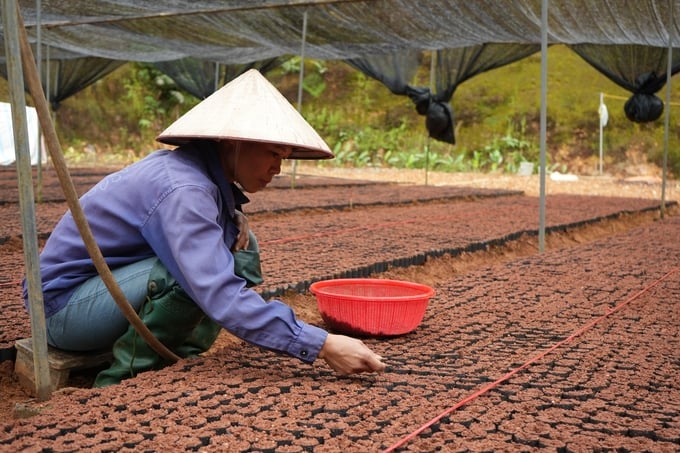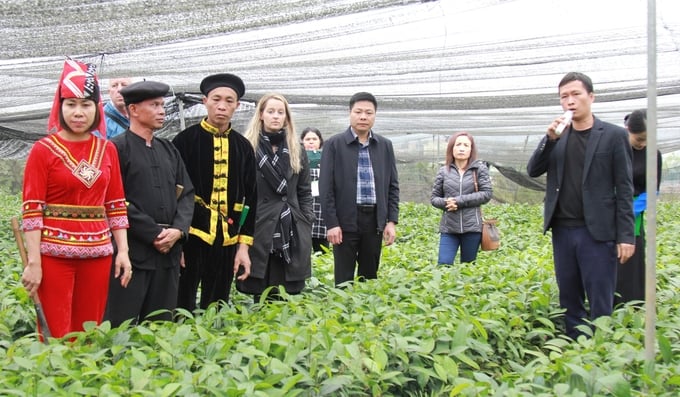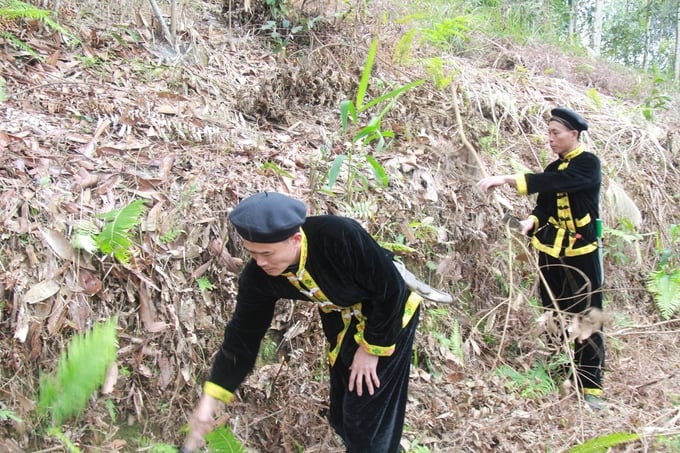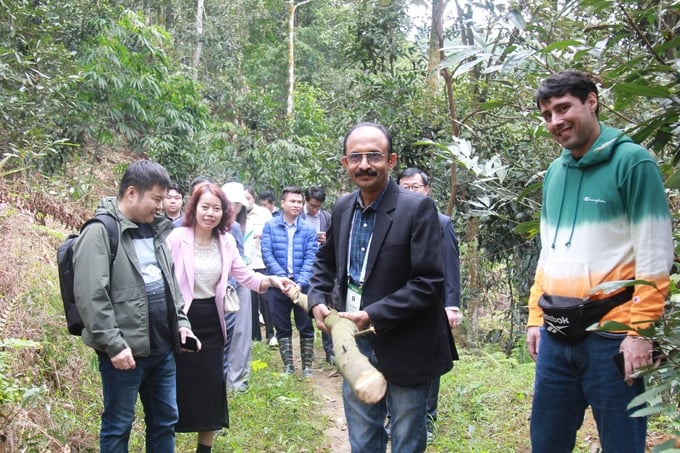May 31, 2025 | 10:57 GMT +7
May 31, 2025 | 10:57 GMT +7
Hotline: 0913.378.918
May 31, 2025 | 10:57 GMT +7
Hotline: 0913.378.918

Over the past ten years, the area of cinnamon in Van Yen district has increased sharply. Photo: Thanh Tien.
For an extended period, the cinnamon center of Van Yen, Yen Bai has prioritized the expansion of its area. Several localities were subjected to an uncontrolled bulk planting of cinnamon plants. This resulted in a significant increase in the area of cinnamon, which increased from 30,000 ha to over 50,000 ha in a mere five years. Additionally, the proliferation of hundreds of agricultural households and facilities resulted in the creation of employment opportunities for thousands of local laborers.
Nevertheless, the uncontrolled expansion resulted in some negative consequences, such as the conversion of numerous areas that were previously used for other material plants, such as tea, acacia, and cassava, into cinnamon areas. Even a substantial portion of the natural forest was illegally encroached upon to cultivate cinnamon. In addition to the unregulated accumulation of seeds that fail to undergo quality inspection by competent agencies, the demand for cinnamon seeds increases as the cinnamon area expands, resulting in substandard seedling quality.

Cinnamon nurseries are springing up like mushrooms after the rain, causing a crisis of overproduction and difficulties in managing the quality of seedlings. Photo: Thanh Tien.
The population is reliant on unsustainable agricultural practices, chemical-based pesticides, and the excessive use of fertilizers, despite the extensive planting. In particular, the environment has been devastated by the widespread use of herbicides, which has resulted in soil and water pollution and has harmed the health of the local population. Furthermore, product consumption encounters challenges because large enterprises necessitate high-quality products for export processing, while the quality of the products produced by local producers does not meet the standards. Products that contain pesticide residues are exceedingly challenging to market, and they are priced at a low level for domestic consumption.
The cinnamon export markets have been impacted by the Covid-19 pandemic and conflicts between countries over the past three years. The value of cinnamon products has substantially decreased, with the price of cinnamon bark and essential oil occasionally dropping by approximately 30%, as the cinnamon industry has experienced a slowdown.
Van Yen district and Yên Bái province, in particular, have adopted specific strategies to enhance the raw material region and preserve the brand of the nation's largest cinnamon region in response to this circumstance. Mr. Pham Trung Kien, Vice Chairman of the Van Yen District People's Committee, stated that the district intends to develop the cinnamon raw material region in order to maintain a stable area of approximately 60,000 hectares. The district will not expand further but will concentrate on key areas of approximately 35,000 hectares to produce following organic standards and achieve international organic certifications for export purposes.

Van Yen district orients people to develop cinnamon in a sustainable direction, creating products that meet the requirements of demanding markets. Photo: Thanh Tien.
Furthermore, the company is attempting to expand its presence in developed countries and demanding markets by sustainably diversifying all cinnamon products and developing standard-compliant, organic products. Concurrently, the promotion of propaganda, advertising, and the invitation of domestic and foreign investors to construct factories in the Van Yen district in order to engage in the deep processing of cinnamon products.
Additionally, the preservation of cinnamon products is a key component of the development of community tourism and experiential tourism in long-standing cinnamon-growing regions, as it is associated with the preservation of the rich cultural identity of the local ethnic groups. The district will concentrate on the development of cinnamon bark processing facilities, essential oil refining, and other cinnamon products in the near future. This encompasses the improvement of the productivity and value of cinnamon products by leveraging scientific and technical advancements in processing.
The most critical component of organic cinnamon production is the transformation of public perception. For many years, the majority of Van Yen residents have employed conventional agricultural methods, which include seed selection, fertilization, care, weeding, and harvesting. Traditional methods offer only one benefit: reduced labor. However, they also have adverse effects on the environment, human health, and market consumption.
In recent years, the agricultural sector of the Van Yen District Department of Agriculture and Rural Development has actively encouraged and supported individuals to cultivate cinnamon in concentrated areas and produce organically, according to Mr. Nguyen Van Quyen, the Deputy Head of the unit.
The district has collaborated with NEDSPICE Binh Duong Company, Son Ha Spice Flavorings Company, Olam Vietnam Company, the Forest Protection Research Center (under the Vietnam Academy of Forest Sciences), and the Provincial Agricultural Extension Center to conduct training sessions for thousands of farmers on sustainable cinnamon production techniques in an organic manner. The objective is to establish high-quality raw material areas and expand the consumption market.
Furthermore, the local agricultural extension officers, in collaboration with local authorities, have implemented propaganda, mobilization, training, and the transfer of technical advancements in cinnamon production, including the selection of forest seeds, seedling nursery, planting, care, harvesting, and processing of products. They are advocating for the production of cinnamon sustainably and organically.

People apply manual farming methods, do not use chemicals in cinnamon production. Photo: Thanh Tien.
A concentrated organic cinnamon cultivation area of over 35,000 hectares has been planned in the Van Yen district to date. The territory that has been certified as organic exceeds 11,000 hectares. Additionally, the district has established four cinnamon value chains, which involve enterprises that serve as intermediaries between cooperatives and export markets. The district is also encouraging the establishment of cooperative groups and cooperatives to enhance connections among agricultural households, thereby establishing concentrated raw material areas that are connected to enterprises for product consumption.
Mr. Nguyen Van Ty's family in An Thinh commune (Van Yen district) possesses nearly 5 hectares of hilly forest land that is wholly covered in cinnamon.
In 2017, agricultural extension personnel and technical staff from Son Ha Spice Flavorings Company provided training and guidance to Mr. Ty's family and numerous other households in the village on the cultivation of organic cinnamon. Organic farming involves the assistance and direction of individuals in the selection of high-quality genetic source seedlings, as opposed to the use of chemical fertilizers and pesticides. The cultivation process is predominantly conducted using natural methods, such as the use of organic fertilizers or the natural growth of the cinnamon trees. Weeds are managed manually or with brush cutters.

Thanks to organic production, the value of cinnamon products increases by 5 - 10%. Photo: Thanh Tien.
This method necessitates additional labor, but it decreases the expense of fertilizers and herbicides. Companies purchase these products at a price that is 5-10% higher than that of those without organic certification, according to Mr. Ty.
Presently, the locality is experiencing an expansion of the organic cinnamon production movement as a result of its numerous advantages. In addition to enhancing the productivity, quality, and value of cinnamon products, the transition from small-scale to commodity production in an organic direction also benefits the locality by reducing environmental contamination, protecting natural water sources, and ensuring community health.
Translated by Linh Linh

(VAN) Several scientists and farmers are experimenting with soil treatment in some key durian-growing regions such as Cai Lay (Tien Giang), Dak Song, Gia Nghia, and Dak R’lap (Dak Nong).
/2025/05/25/4127-3-073637_820.jpg)
(VAN) Thanks to the promotion from an FAO-implemented project, vegetable production in greenhouses in Moc Chau has seen strong development, from 1.5 hectares in 2021 to nearly 50 hectares in 2024.

(VAN) FAO has recently supported USD 140,000 to implement the project 'Risk mitigation human-animal interface risks through disease control initiatives in pig farming.'

(VAN) The People's Committee of Tra Vinh province has approved an adjustment to the investment policy for the Green Hydrogen Plant project, increasing its area to approximately 52.76 hectares.
![Reducing emissions from rice fields: [2] Farmers’ commitment to the soil](https://t.ex-cdn.com/nongnghiepmoitruong.vn/608w/files/news/2025/05/05/dsc08881jpg-nongnghiep-140632.jpg)
(VAN) Clean rice cultivation model in Thuong Tan commune, Bac Tan Uyen district, is assisting local residents in achieving sustainable agriculture by substantially reducing costs, increasing productivity, and protecting the environment.

(VAN) At the conference to disseminate Resolution No. 68, AgriS introduced its digital agricultural ecosystem and reaffirmed its commitment to accompanying the Government in promoting private sector development and sustainable agriculture.

(VAN) 'Blue Ocean - Blue Foods' initiative is designed to restore marine ecosystems and establish sustainable livelihoods for local communities by cultivating a minimum of 1,000 hectares of cottonii seaweed in the first three years.